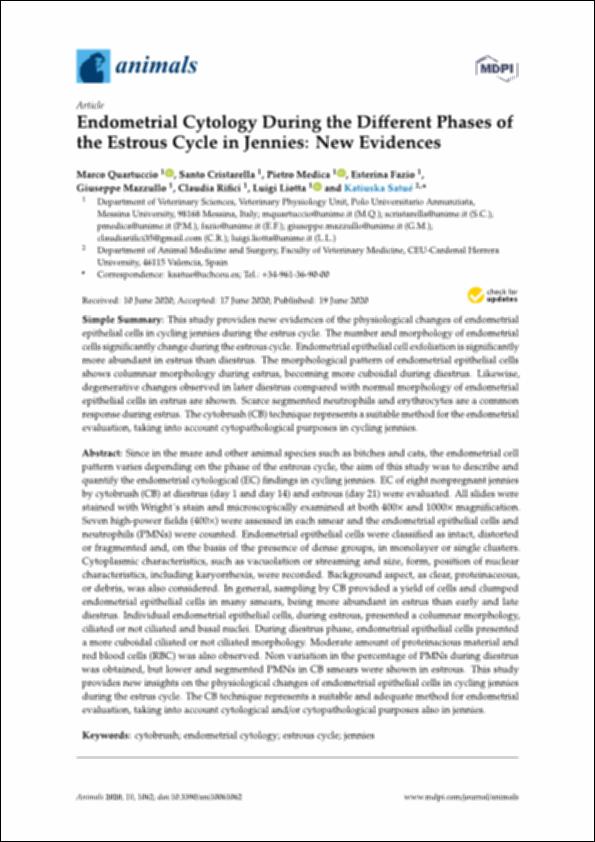Por favor, use este identificador para citar o enlazar este ítem:
http://hdl.handle.net/10637/12497Endometrial cytology during the different phases of the estrous cycle in Jennies : new evidences
| Título : | Endometrial cytology during the different phases of the estrous cycle in Jennies : new evidences |
| Autor : | Quartuccio, Marco Cristarella, Santo Medica, Pietro Fazio, Esterina Mazzullo, Giuseppe Rifici, Claudia Liotta, Luigi Satué Ambrojo, Katiuska |
| Materias: | Horse breeds - Jennies - Generative organs - Cytology.; Estrus.; Estro.; Caballos - Razas - Jennies - Aparato genital - Citología. |
| Editorial : | MDPI |
| Citación : | Quartuccio, M., Cristarella, S., Medica, P., Fazio, E., Mazzullo, G., Rifici, C. et al. (2020). Endometrial cytology during the different phases of the estrous cycle in Jennies: new evidences. Animals, vol. 10, i. 6 (19 jun.), art. 1062. DOI: https://doi.org/10.3390/ani10061062 |
| Resumen : | Since in the mare and other animal species such as bitches and cats, the endometrial cell pattern varies depending on the phase of the estrous cycle, the aim of this study was to describe and quantify the endometrial cytological (EC) findings in cycling jennies. EC of eight nonpregnant jennies by cytobrush (CB) at diestrus (day 1 and day 14) and estrous (day 21) were evaluated. All slides were stained with Wright´s stain and microscopically examined at both 400 and 1000 magnification. Seven high-power fields (400 ) were assessed in each smear and the endometrial epithelial cells and neutrophils (PMNs) were counted. Endometrial epithelial cells were classified as intact, distorted or fragmented and, on the basis of the presence of dense groups, in monolayer or single clusters. Cytoplasmic characteristics, such as vacuolation or streaming and size, form, position of nuclear characteristics, including karyorrhexis, were recorded. Background aspect, as clear, proteinaceous, or debris, was also considered. In general, sampling by CB provided a yield of cells and clumped endometrial epithelial cells in many smears, being more abundant in estrus than early and late diestrus. Individual endometrial epithelial cells, during estrous, presented a columnar morphology, ciliated or not ciliated and basal nuclei. During diestrus phase, endometrial epithelial cells presented a more cuboidal ciliated or not ciliated morphology. Moderate amount of proteinacious material and red blood cells (RBC) was also observed. Non variation in the percentage of PMNs during diestrus was obtained, but lower and segmented PMNs in CB smears were shown in estrous. This study provides new insights on the physiological changes of endometrial epithelial cells in cycling jennies during the estrus cycle. The CB technique represents a suitable and adequate method for endometrial evaluation, taking into account cytological and/or cytopathological purposes also in jennies. |
| Descripción : | Este artículo se encuentra disponible en la siguiente URL: https://www.mdpi.com/2076-2615/10/6/1062 Este artículo pertenece al número especial "Reproduction, fertility and embryonic development of animals". |
| URI : | http://hdl.handle.net/10637/12497 |
| Derechos: | http://creativecommons.org/licenses/by/4.0/deed.es |
| ISSN : | 2076-2615 (Electrónico). |
| Fecha de publicación : | 19-jun-2020 |
| Centro : | Universidad Cardenal Herrera-CEU |
| Aparece en las colecciones: | Dpto. Medicina y Cirugía Animal |
Los ítems de DSpace están protegidos por copyright, con todos los derechos reservados, a menos que se indique lo contrario.


